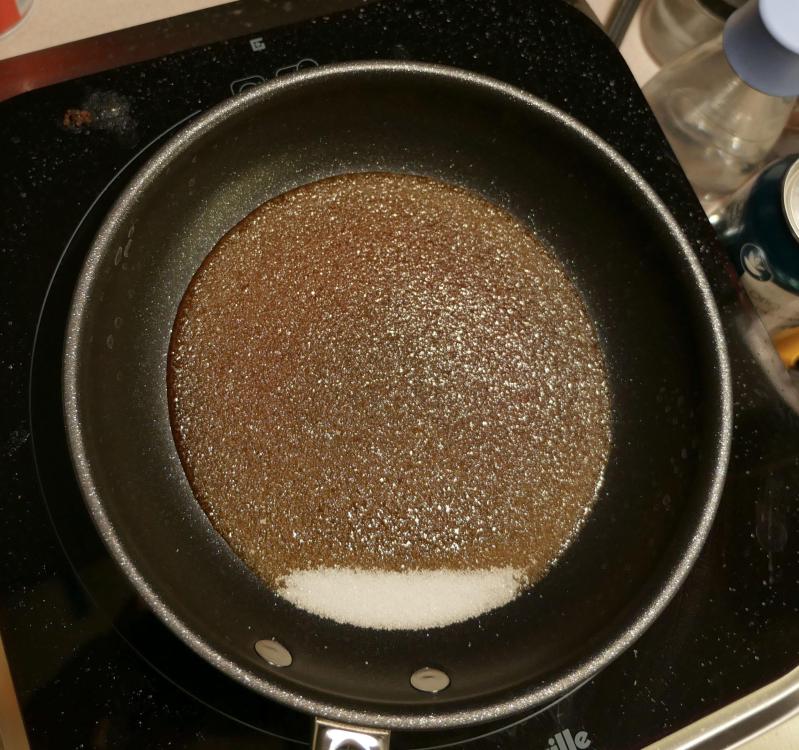
adrianvm
participating member-
Posts
111 -
Joined
-
Last visited
Content Type
Profiles
Forums
Store
Help Articles
Everything posted by adrianvm
-
Do you think they are support for the Control Freak or support for the web site for their subscription and such? The product is sold by Breville and their support sucks. I've been trying to get answers from them for a couple weeks at this point about recommended pans and allowable pan concavity as I grow increasingly suspicious that there is no such thing as a flat pan.
-
Anybody know the diameter of the control freak coil? I didn't see this spec anywhere. Here's a picture from their promo video. I think the marked circle is 9.5". I also wonder why there is a gap in between the two rings.
-
If the induction heater heats out to a 9" diameter, why does the temperature fall off before the nine inch mark? Shouldn't the pan be getting heat there?
-
Tried measuring a very large cast iron skillet with the Control Freak set to 250 on slow intensity. After about 20 minutes it is in steady state with the center at 260, a point 2" off center is 260, a point 4" off center is 230, and 5" the temperature is 200. It took quite a while to reach steady state and overshot by a lot (up to 290) on the "slow" speed. Tested 12.5" Demeyere proline skillet. This one was also pretty slow to heat. Is stabilized at 236 deg center, 243 at 2", 225 at 4", 215 at 5", and 205 at 6" (which is up the sidewall). Surprisingly good heat up the sidewall, actually. I saw the claim on a review site that Demeyere proline can hold as much heat as cast iron. But my experience is that cast iron is dramatically more effective at browning than proline. Am I missing something?
-
My bread definitely might not perform the same. But knowing that procedure is helpful because it suggests something about what's necessary to melt the cheese. One thing I did notice is that it seemed like I was never at risk of overcooking the sandwich. On my gas stove sometimes while trying to melt the cheese I end up burning the bread and that never seemed to be a danger.
-
Perhaps the almond bread isn't "great" for this application, but it makes a decent sandwich and dietary constraints make it one of the best options. And in any case, that's the problem at hand. I don't know if a wheat bread process is radically different. I recall encountering similar issues with getting the cheese to melt when the bread browns. McGee says Maillard browning "becomes noticeable" around 230 F and has a table that lists it as happening at 250 F. In fact, 250 F was the temperature I dropped to when browning was too fast at 325 F. I don't find that I'm particularly enlightened---my recalled temperature thresholds seemed to be basically right. Maybe what I need to understand is not how browning happens but how the cheese melts. Note that I'm using a cheddar which is not a fabulous melter but is an OK melter---and it does melt. Most better-melting cheese are too bland and making my own processed cheese with sodium citrate is too much trouble for this (and also my wife doesn't like that kind of processed cheese). The idea of microwaving the cheese first seems promising, though I usually butter the bread. What stovetop conditions are needed to melt the cheese? I could cover the pan and heat below browning temperature to soften the cheese, then uncover it and brown both sides, perhaps.
-
The thermocouple that read 260 at the pan center is the same one that read 238 when doing this test on a different pan, and correctly reads at room temperature. Maybe it broke. I haven't done any calibration tests on it and I don't have prior experience with thermocouples. When I got the 260 reading it seemed to be stable. I waited a couple minutes and saw no change. When I say 228 at the "edge" of the pan I mean about 1cm in from the edge of the flat part of the pan that will be in contact with the induction heater---so still over a portion of the pan that should be getting heat. I readily admit that by measuring empty pans I'm measuring the thing that's easy to measure, not the ideal thing. It's not clear to me how the Chefsteps egg recipes rely on the intensity setting, or how things would work differently with a lower intensity. Would the pan fail to keep temperature at low intensity (in the presence of actual food) and therefore the eggs would cook more slowly and at a lower temperature? The interesting thing about the chefsteps recipe is that they provide several ways to get different results at different cooking temperatures ranging from I think 130 F up to 400 F. But what role does that intensity setting play? If I'm following their 350 F or 400 F egg recipe, why might I want to disobey their instructions and use medium or low intensity? I asked Cristel how thick the aluminum is in their pans and got the rather weird answer that it's 1/2" to 3/4" thick. Somehow I doubt that's correct. I wonder if they meant 1/2 cm to 3/4 cm. Anybody have experience with their handle system?
-
Looks like someone moved the discussion of pans to a different thread on Induction Friendly Cookware. Not unreasonable, but kind of confusing when notifications linked to nonexistent messages. So here's a question about cooking. I'm trying to make a grilled cheese sandwich, but using a weird bread made out of almonds that doesn't brown the same way as wheat bread. I tried cooking at 325 and the bread browned in 30 seconds and the cheese was still cold. So I tried lowering the temperature but it seemed like it was then too low to brown, so I raised it and then got a similar situation where it was brown on the second side, but the cheese still wasn't melted. Then I ended up waiting a very long time for the cheese to melt after both sides were brown, probably at 285 or something like that. Should I be looking for the coldest temperature that browns? Does a given temperature produce a given fixed amount of browning? (In other words, is browning like meat cooking that it happens based on temperature rather than time?) Like can I sit at 325 indefinitely without browning any more? And what conditions are needed to melt the cheese more quickly? (I never figured out how to make this work reliably on my gas stove but I think tend to have a reverse problem of cheese melted and leaking out but sandwich not brown yet.)
-
I would think that amount of overshoot should depend mainly on the mass of the pan, which is why I found the large overshoot on the Falk surprising. But what about the steady state behavior where I have it set to 250 and the Falk is at 260 in the center and 228 at the edge? That seems weird, and very much not even. This is a 24cm pan, and the contact area is a bit under 20cm. How do you maintain a higher temperature at the top side of the pan than underneath? I have observed that once a steady state is achieved, changing the Control Freak intensity seems to have no effect. (That's not surprising.) Would you suggest doing the sugar test from cold but at slow? Or as previously suggested waiting until steady state and then adding the sugar? Note also that the middle priced pan is an aluminum clad pan, not a disk pan and it's more even than the Falk. I have never used any other induction cooker---only gas. With regards to the right intensity choice, Chef Steps has some "Precision Scrambled Eggs" recipes that all specify using high intensity. Mistake? Pan dependent? Are there any disk pans with these super thick disks where the disk goes reasonably close to the edge of the pan? Demeyere Atlantis is just 2mm copper, so it wouldn't qualify. Not sure about that Scanpan Impact---can't find specs. Seems like Cristel has some edge-to-edge pans, but don't know how thick their bases are. This handles are bizarre. Anybody used the cristel handles? They look like they wouldn't work very well.
-
The caramel tests I started from cold. So you're suggesting I should bring the pan to temp first, then add the sugar? I'll need to figure out a way to spread the sugar evenly into the hot pan for this test to work, I think. Note to Palo: cleaning up caramel is simple: soak the pan in water and it dissolves. I left them over night and there was a little bit not dissolved. It came off somewhat more easily from the nonstick pans, and I ran the Falk under hot tap water for a minute to clean it out so I could make a Bacon Brie Frittata this morning. This came out more evenly cooked on the Freak, cooking at 250 than when I cook it on gas at medium low. (But not quite fair comparison because I've never used the Falk pan on gas---usually make this in an All-clad masterchef that's not induction compatible.) On gas the edge cooks faster than the middle and my result on the Freak was more uniform.
-
I uneven heating a problem generally with induction? I would have thought that it would be more even than gas, say. What I dislike about many of the disk base pans is that the disk has a 1" smaller diameter than the pan, so you have a bunch of pan that doesn't work around the edge. Demeyere Atlantis is an exception and it looks like that Scanpan is as well. Fissler, Paderno Grand Gourmet, and Silga Technika all seem to suffer from the undersized disk problem. I have a Sitram catering pan like this that has a copper base; I've been using it with gas (not induction compatible) and it's a 9" pan disguised as an 11" pan---nothing cooks around the edge. I tried heating pans on fast on the CF to 367 with a layer of sugar in the pan. I think I should have made more of an effort to control the amount of sugar, as it seemed like that affected how things looked. But here are the results. The pics are after about 5 minutes. I noticed that caramel had already formed on the Falk after 2 minutes; no other pan did that. I did a brief time (20s maybe) at 380 before turning off the heat after about 8 minutes. First pic is analon 10" fry pan, second falk 9" fry pan, third is demeyere dutch oven, fourth is hestan 8.5" fry pan, and finally a pic of the three frying pans together after it cooled.
-
I'd like to be able to rely on the Control Freak to do as much as it can do, so I don't want to be limited because I bought the wrong cookware. I tend to be more of a high heat cook who forgets to watch the onions because I'm cooking 3 things at once and then I'm trying to decide if I burnt them or not. Regarding cookware, it's been suggested more than once in this thread, and also by the CF manual, that the cookware should be flat, for example. But both of the new pans I bought are not flat. That seems like it could decrease heating closer to the center and lead to more heating at the pan edge. But how much concavity is required for this to be noticeable? I also just like to understand what's going on, and right now I don't. I've talked to several physicists about it and nobody can explain the my observations---so it's a puzzle. The sugar test seems like an interesting one for seeing how pan contents get heated. I got a Falk pan and it seems to display the worst performance yet, with a 260 deg temp in the center and 228 at the edge. How can it be hotter in the center than the set temp of 250? I also did a set of high speed tests. On that test the Falk center peaked at 323 (side peaked earlier at 265) and steady state was 249 center, 235 edge. The Analon pan peaked at 285 center, 270 side and settled at 249/248. The Hestan pan peaked at 298 center, 310 side and settled at 245/252, which note is better than where it settled on low speed. Pretty interesting that temperature uniformity seems to be inversely proportional to how much the pan costs. Is a highly responsive pan a liability with the CF control loop?
-
If there's an incompatibility between my pan and the CF I'd like to know so I can return the pan and get a different one. Any thoughts on a test that involves cooking that would be enlightening?
-
Only one of three multilayer pans is giving a large temperature difference. Also note that this is the steady state temperature, not dynamic temperature. Aluminum has about 10x the conductivity of stainless steel. How do you maintain a 14 deg temperature difference vertically across 3mm, mostly aluminum, in steady state? Heat *must* be moving upward to equalize the temperature, so it seems like the only way is losses at the top side, like heat being lost to the air. But why would more heat be lost for one skillet than another? @horseflesh My testing was all at 250 F, a fairly low temperature I chose because I figured it was safe for empty cookware to sit at that temperature, even nonstick, and no great concerns of overheating if there are overshoots. So if you want to try to match my tests, use that temperature. Note that I found the IR thermometer measurements with my point IR thermometer were ~30 deg high on nonstick.
-
It's the Thomas Keller Insignia Titium nonstick 8.5" skillet. I think it's the same as the probond titium nonstick. I am not sure where I got the 3mm thickness number from---they don't advertise it on their site. I think maybe it was a reddit post that says: "FWIW I asked Hestan directly and was told the frying pans are 3mm, and everything else is 2.3mm. This lines up with what I saw in the store." I think that's total thickness, not aluminum thickness.
-
Yeah, I'm not shocked that the pan center outpaced center readings as the pan was heating. But I am puzzled that for one pan, steady state has the Freak measured temperature 15-20 degrees higher than the thermocouple measured temperature at the pan center, above the Freak sensor. Does that mean the top surface of the pan is 15-20 deg below the bottom in steady state? Sensor readings should not be **higher** than actual temperature due to any sort of coupling issue. So is there a temperature gradient vertically across the pan thickness and if so, why is it larger for the Hestan pan and smaller for the Analon and Demeyere pans? Is something wrong with the Hestan? And if so, what? Note that the Hestan pan is 3mm thick which might mean it has the thinnest base of the three pans.
-
I tested 3 pans using a pair of thermocouples, one that I tried to place in the pan center and one that I placed at the pan edge. I tried an off-brand of Kapton tape but it let go very quickly as the pan heated. A very large piece of blue painter's tape worked OK to hold the thermocouples in place. All tests were to 250 F on low intensity with an empty pan. The first pan was the 8.5" Heston nonstick skillet. This is a clad pan with a concave bottom (1mm concavity). When the pan temperature was stable and the CF was reporting 250 measurements at the pan center ranged from 236-238. Measurements at the pan edge ranged from 243-246. IR thermometer measurements towards the edge were 272-276. The second pan was the Analon Copper, 10 inch fry pan. This pan has a flat disk base that allegedly contains copper. The base is concave by a similar amount as the Hestan, about 1.1mm. With this pan the center measurements ranged from 246-250. I did have one low measurement at 243. The edge measurements (still over the disk base) ranged from 243-245. The IR thermometer reported 268-276. The third pan was a Demeyere Atlantis dutch oven with a 9 inch base diameter. This is the thick base style pan that has 2mm copper in the base. This pan is something like 15-20 years old. The bottom of the pan is somewhat warped, but convex, not concave. It's hard to estimate the size of a convexity, but maybe it's around 0.3mm. With this pan, the center measurement was between 248-253. The edge measurement was 241-245. For completeness I tried the IR thermometer on this pan and it read 115. (A bad reading is expected due to the stainless steel cooking surface.) In all cases when the pans were heating up the pan center seemed to outpace the sensor, reading ~8 deg F warmer than the sensor was reporting. So it seems like the CF is most likely working correctly. The big discrepancies I observed before in steady state temperature were IR thermometer readings and they seem to be high. I'm not sure what to make of the Heston pan performance. One of the questions is whether to return that pan. Why is the pan temperature lower than the CF setting? How can this happen? That implies that the CF is reading a hotter temperature than the pan actually is. Or that the pan is 12-14 degrees F colder at the top surface than the bottom in steady state. Another observation is that the Analon seems to do OK in this test despite its concave bottom. Finding pans that are not concave seems to be somewhat difficult.
-
The business of counting layers is kind of silly. What matters is what the layers are. I never understood why All Clad was sticking extra stainless steel layers into their pans. But that's not what Demeyere does. They seem to be counting "layers" that are just junction materials between the main pan materials---layers that presumably are of negligible thickness. It's marketing. You have to be careful when comparing Proline/Atlantis to Industry 5. My understanding is as follows. Proline skillets are 4.8mm thick. Industry 5 skillets are 3mm thick. Clearly Proline will be better. But other clad pieces are the same thickness (3mm) in both Atlantis and Industry 5 lines, so for the sauciers I'm looking at, both Atlantis and Industry 5 are 3mm thick. It's a bit of a contradiction to say that more layers isn't better but then that you prefer proline, which is "7 layers". So what are these 7 layers? They are "triplinduc" then pure aluminum, aluminum alloy, pure aluminum, stainless. The aluminum alloy is supposedly more heat conductive than pure aluminum. The "triplinduc" is three layers of stainless steel that is supposedly "30% more efficient" on induction than other materials. The disk base Atlantis pans also have "7 layers" which are triplinduc, silver, copper, silver, stainless. Somehow I doubt those silver layers are more than a few microns thick, but they can't hurt pan performance since silver has better conductivity than copper. So getting back to the question of whether it's worth paying more for the Demeyere Atlantis saucier vs the Industry 5 saucier, it appears that the difference between the two products lies entirely in the mysterious "triplinduc" material, which is used in the Atlantis but not the Industry 5. Those are the "layers" you lose. So is this special induction material actually delivering some detectable advantage? They claim that it's more magnetic and has more resistance to deformation. In terms of special materials Demeyere also has an intriguing material they call Controlinduc that is designed to prevent overheating of the pan. Not of practical interest to Freak owners, but I thought it was interesting: as the pan heats past a threshold (225C) the base begins to lose its magnetic properties, so the induction cooker cannot heat it hotter than about 250C. I would imagine that Falk should be better than the Atlantis clad pans because it has almost as much copper as the Atlantis and industry 5 pans have aluminum. But the Falk is quite a bit more expensive, I think more than double in some cases.
-
Analon Copper which has been recommended a bunch is also quite concave on the bottom. What nonstick pans are not concave?
-
@afsYou mentioned earlier using Falk and Demeyere on your CF. I was looking at sauciers and wondering, for a pan like this, whether the difference between the 5 layer and 7 layer pan is noticeable at all. Or how those pans compare to the Falk with copper instead of aluminum. From what I can tell, the only difference between the 5 layer and 7 layer pans (Atlantis and Industry 5) is that the Atlantis has the magical "triplinduc" layer on the bottom and the Industry 5 just has stainless steel. Otherwise they have the same construction with apparently the same amount of aluminum.
-
I've noticed this problem with the sales staff not knowing the pan thickness. I asked one brand and the sales staff measured the pan thickness themselves and gave me a number. But they don't know how thick the aluminum portion is. I asked another brand and they didn't know, but they were able to get the information from "the engineers" in about a week. I think the explanation for the secrecy has got to be the one given by Laurentius: they just are doing everything they can to minimize potentially unfavorable comparisons. The less actual information we have the harder it is to make meaningful comparisons, which might be unfavorable. The manual for the Control Freak Home is somewhat vague about what they mean by pan size with the 5.5" value. The little diagram shows a pan being measured at the top, but it is a pan with vertical sides. Of course, even many straight sided pans have a smaller base then their top diameter. When I tried to do temperature measurements with my very tippy All-Clad windsor nearly empty, the pan was so off-center that I got sporadic messages that the pan was not on the temperature sensor. But it always seemed to actually detect the pan. Of course, operating this way is clearly not ideal---better for the Freak to measure the temperature in the center of the pan---but it seemed to work.
-
Regarding the Analon copper that has been mentioned several times here as a good nonstick option, I wrote to Analon to ask about the construction and got this reply: "While we appreciate your interest in the construction of our cookware, we regret to inform you that specific details regarding the thickness of the stainless steel, aluminum, and copper layers are proprietary information and cannot be disclosed." I would assume this means that they have something to hide about the construction.
-
The manual does say "Cookware smaller than 5.5"/14cm may not work (material dependent)". So it seems like it's not a clear cut hard boundary. Can anybody identify a 6" pan that fails? That is, what sorts of pans are harder to detect? Or very small pans that work fine?
-
So even though the manual says 5.5" the pan detection won't reliably detect a pan at that diameter? I haven't noticed problems with pan detecting using my All-Clad windsor pan, which has a base of about 5.75 inches. Could this behavior be different between the original Freak and the Home version?
-
Most of my measurements were of a nonstick pan, not stainless. When I did measure stainless I put oil in the pan so I was measuring oil rather than metal. Any advice on buying a thermocouple I can tape to the pan without spending a lot? And type of tape to use? (The thermocouples I have are for sous vide, pointy probe shape tips.) Note that now that I understand how things work the thing that is bothering me is that the steady state temperatures I'm getting are higher than the set point by 20-40 deg depending on the pan. And yes, this doesn't make sense thermodynamically, so it suggests that either the Freak is misreading the temperature or my thermometers are. It seems important to figure out which one. On this very thread people have been suggesting the Analon copper pans. These are advertised to have a layer of copper in the base that spreads the heat and visibly appear like they have a quite thick layer. But Analon (like almost every other pan manufacturer, I'll note) says nothing about how thick any of the layers are, and the pans are cheap at $70 for a set of two skillets. I asked them and have not heard back. This is not uncommon, though. The pan companies tell you how many layers there are but not how thick anything is, like Demeyere is supposed to be great because it has 7 layers! Maybe it'll be even better next year when the 9 layer version comes out! I asked another vendor about their pan thickness and they didn't know but did eventually get the information---it took a week. Wouldn't cast iron be uneven on every heat source? The Freak manual says minimum pan size is 5.5 inches. Why do you think it is actually 6.3"? What goes wrong if the pan is smaller than 6.3 inches?






